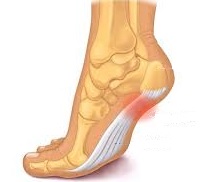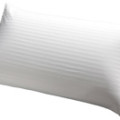If your foot frequently hurts, you may be asking yourself, “do I have plantar fasciitis?” Does your heel hurt when you walk – especially in the morning or after sitting a long time? Does you foot tend to cramp up when you walk barefoot or in flip-flops? If you answered “yes” to any of these questions you could be suffering from plantar fasciitis.
What is Plantar Fasciitis?
Plantar fasciitis is an inflammation, irritation to the plantar fascia and is the most common cause of heel pain. Plantar fasciitis is an overuse injury and causes a stabbing, burning pain in the heel especially upon awakening and after prolonged sitting.The plantar fascia is a fan shape band of tissue that connects the heel to the toes on the plantar surface (the part that contacts the ground) of your foot. This thick,strong ligament supports the arch of the foot acting like a bow string.

What Causes Plantar Fasciitis?
Plantar fasciitis is caused by increased tension in this bow string causing tiny tears in the fascia leading to inflammation. The following can predispose someone to developing plantar fasciitis:
- obesity
- some foot types including flat feet, high arch, and plantarflexed first ray
- exercises such as long distance running and dance
- jobs that require long periods of standing and walking
- improper shoe wear including flip flops, barefoot, and shoes without arch support
- tight calves
Why Does it Hurt When I Wake Up?
When you sit and sleep, your foot is held in one position (usually plantarflexed or pointed). This position shortens the plantar fascia and causes it to tighten. When you step on your foot, the plantar fascia is being stretched causing the tearing and pain. This is the important reason to stretch the fascia before taking your first steps. (see below for stretches)
What is the Treatment for Plantar Fasciitis?
Most plantar fasciitis can be treated conservatively and heals within a month, but if left untreated it can become a chronic condition. The first thing to look at is your shoe wear. Make sure your shoes have arch support and avoid all barefoot walking…even in your house. Depending on how painful your heel is you may want to purchase an over the counter heel cup. Next, you want to make sure you are stretching the fascia before taking your first steps when you wake up and after prolonged sitting.
You may need to alter your activity/exercise while your fascia is inflamed. The tricky part about this is that most people with plantar fasciitis do not have pain while exercising because the fascia is staying constantly stretched. But, if it hurts while doing your activity/exercise definitely stop! Again depending on the level of pain and chronicity of the symptoms, ice will decrease the inflammation and pain. The best way to ice the heel is to roll your arch and heel on a frozen water bottle for 5-10 minutes. Some people find benefit from sleeping in a night splint. The night splint keeps that fasica stretched while sleeping so that the first steps in the morning are less painful.
If you are still having pain and have tried all these treatments, please schedule an appointment with a physical therapist or medical doctor for further evaluation. A physical therapist can add ultrasound, iontophoresis, phonophoresis, and manual techniques to assist the healing and prevention of further bouts of plantar fasciitis.
Why Do I Keep Getting Plantar Fasciitis?
Once healed, plantar fasciitis can reoccur if the aggravating factor has not been fixed. For example if you have flat feet and return to walking around your house barefoot or running in a shoe without good support, you can aggravate the fascia again. The best ways to prevent plantar fasciitis are to stretch your foot and calf daily, wear supportive shoes, and watch your weight.
Do I Have Plantar Fasciitis? – Final Thoughts
Don’t delay! The sooner you start treatment for your plantar fasciitis, the better the outcome! If you have any questions on plantar fasciitis, plantar fasciitis treatment, or plantar fasciitis prevention, then please leave them in the comment section below.





